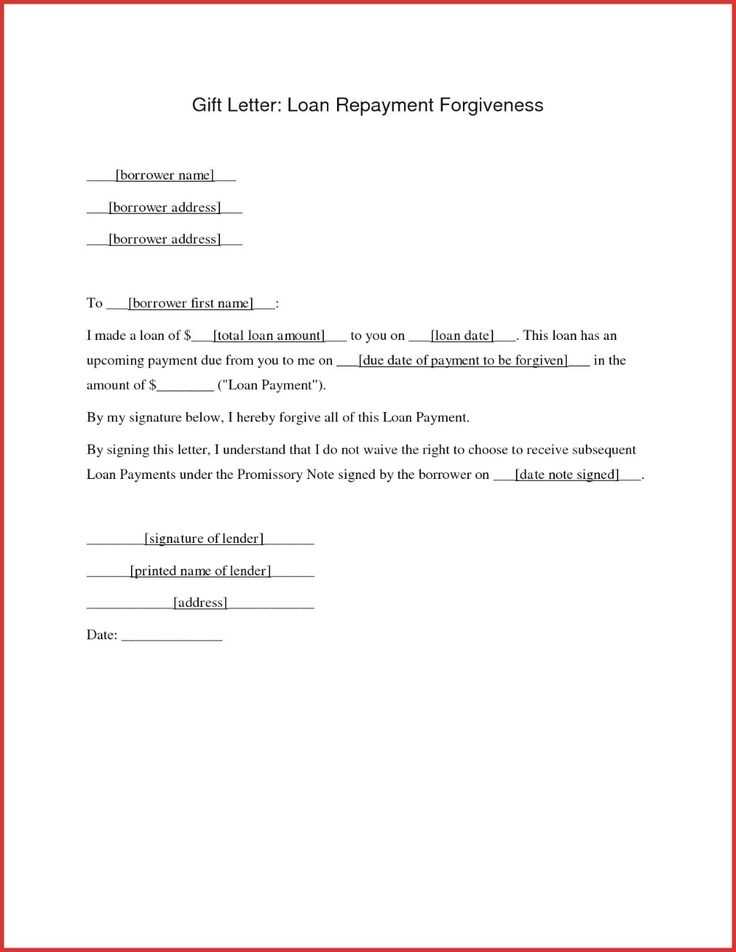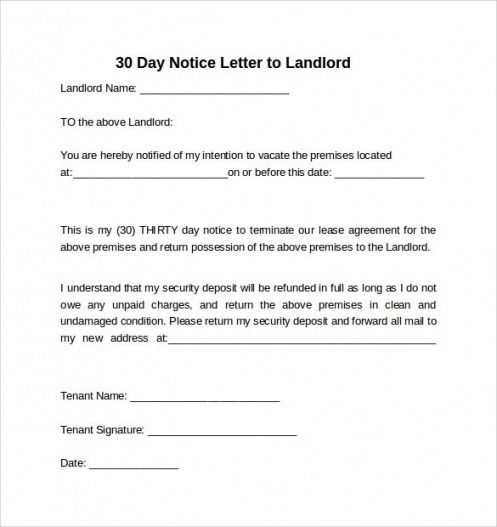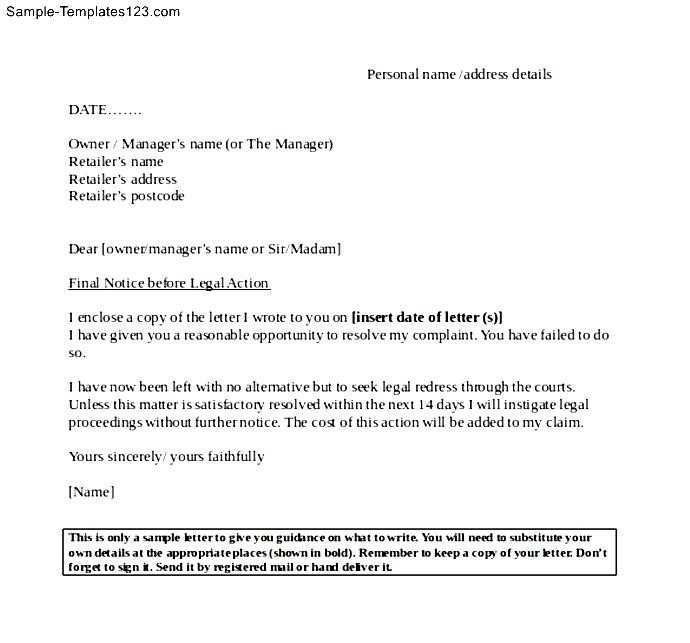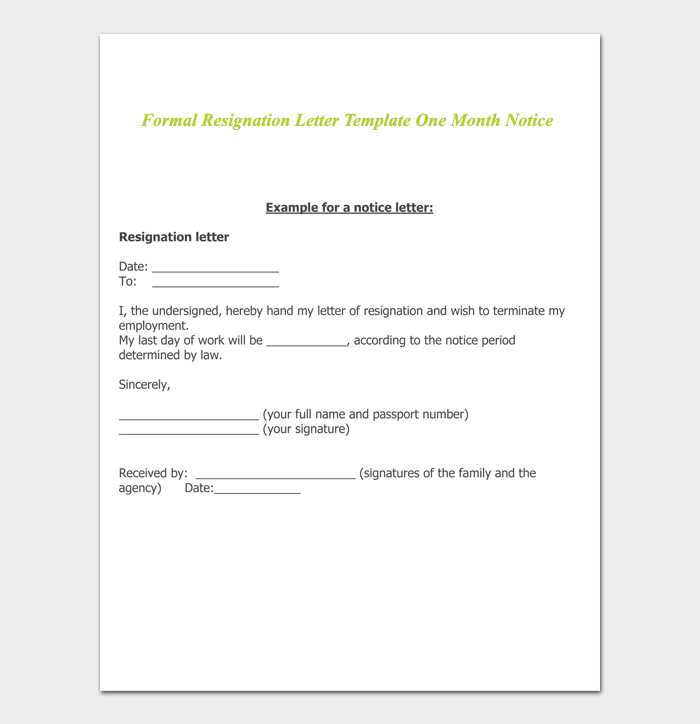Default notice letter template

If you need to send a default notice letter, clarity and directness are key. A well-crafted template can help you address the issue without unnecessary complication. Here’s a simple structure that outlines the necessary components:
Start with a clear heading. Begin the letter with the date of the notice and a subject line that clearly indicates it is a default notice. For example, “Notice of Default Payment” will immediately alert the recipient to the purpose of the letter.
State the reason for the notice concisely. Mention the specific issue–whether it’s a missed payment, failure to deliver goods, or breach of contract–and reference the relevant contract or agreement. Be sure to note any deadlines or conditions that need to be met for resolution.
Provide clear instructions on how the recipient can resolve the default. Include any actions you expect them to take and a reasonable timeline for doing so. If applicable, remind them of the consequences of not responding or resolving the issue within the given time frame.
Maintain a professional tone throughout the letter. Avoid unnecessary emotion or threats; instead, focus on a calm, clear presentation of the facts. This ensures the message is received with the necessary seriousness and respect.
Here’s the revised version:
Make sure your default notice is clear and direct. Start with a friendly greeting, followed by an explanation of the missed payment. Specify the amount due, including any late fees if applicable. Provide a clear deadline for payment and explain the consequences if the payment is not made by that date. Offer a simple way for the recipient to contact you if they have questions or need assistance. Close with a polite reminder to settle the outstanding balance promptly.
For example: “We noticed that your payment for [Invoice Number] due on [Date] has not been received. The total outstanding balance is [Amount], including a late fee of [Late Fee Amount]. Please make the payment by [Due Date] to avoid further actions. If you have any questions, feel free to contact us at [Phone Number] or [Email Address]. We appreciate your attention to this matter.”
This approach ensures the recipient understands their responsibility without feeling threatened, encouraging a prompt response.
- Default Notice Letter Template
When sending a default notice, clarity and directness are key. A well-structured template helps convey the message without confusion. Below is a simple yet effective default notice letter template:
[Your Name]
[Your Address]
[City, State, Zip Code]
[Email Address]
[Phone Number]
[Date]
[Recipient Name]
[Recipient Address]
[City, State, Zip Code]
Dear [Recipient Name],
Re: Default Notice for [Specify the Account or Agreement]
This letter serves as a formal notice that you are in default of the terms of our agreement dated [Date of Agreement], specifically regarding [mention the terms or obligations that have been breached]. Despite previous communications and reminders, the outstanding balance of [Amount Due] remains unpaid, which has led to the current default status.
We request that you address this matter by [Deadline for Payment or Action], failing which we may take further actions, including [describe potential actions such as legal steps or termination of the agreement].
If you believe this notice is issued in error, or if you wish to discuss a resolution, please contact us immediately at [Phone Number] or [Email Address]. We are open to finding a suitable resolution.
Thank you for your prompt attention to this matter. We look forward to your cooperation in resolving this issue.
Sincerely,
[Your Name]
Enclosure: [List any supporting documents if applicable]
A default notice must be clear, direct, and well-organized. Begin with the title or heading at the top, indicating that it’s a “Default Notice” to avoid any confusion.
Next, include the date the notice is issued. This sets a clear timeline for the recipient.
Identify the recipient accurately, including their full name and address. This ensures the notice is directed to the correct party.
Provide a brief description of the situation, clearly stating the nature of the default. Include details such as the specific terms of the agreement or contract that have not been met, and mention the specific obligation that has been breached.
State the amount due, if applicable, and the deadline by which the recipient must respond or rectify the default. Be precise about the due date and avoid any ambiguity.
If relevant, offer a course of action for the recipient to resolve the issue, such as making a payment, returning an item, or fulfilling another contractual obligation. Include clear instructions for what steps need to be taken to address the default.
Finally, specify the consequences of failing to resolve the matter by the stated deadline. This could include legal actions, penalties, or termination of the agreement.
Conclude with a polite but firm closing, offering a contact for further inquiries if necessary.
| Section | Description |
|---|---|
| Heading | “Default Notice” clearly marked |
| Date | When the notice is issued |
| Recipient Information | Name and address of the recipient |
| Default Description | Details of the breach of terms |
| Amount Due & Deadline | Specific amount and due date |
| Action Steps | What the recipient should do |
| Consequences | What happens if no action is taken |
| Closing | Contact information and polite conclusion |
The first section of a default notice letter is critical for setting the tone and ensuring clarity. Start by including the name and address of the recipient. Clearly state the date the letter was sent. This helps avoid confusion and sets a specific point in time for the communication.
Next, indicate the reason for the letter. If it concerns a missed payment or outstanding debt, specify the nature of the issue directly. Provide a summary of the amount owed, including any relevant reference numbers or account details to avoid ambiguity.
Key Elements in the First Section

| Element | Description |
|---|---|
| Recipient’s Details | Name and address of the person or entity being notified |
| Date Sent | The exact date the letter is issued |
| Reason for Notification | Clear statement of why the letter is being sent (e.g., unpaid balance) |
| Outstanding Amount | The amount owed, including reference/account number |
Always keep this section direct and fact-based, with no unnecessary details. This will ensure the recipient understands the situation immediately.
Use clear, straightforward language that leaves no room for misinterpretation. Avoid legal jargon or overly complex terms unless absolutely necessary, and when you do use them, ensure they are defined. This approach helps recipients understand the message quickly and without confusion.
- Be direct: Focus on the facts and state them in a concise, unambiguous manner.
- Avoid passive voice: Use active voice to make the actions and responsibilities clear. For example, “You must pay the amount due” instead of “The amount due must be paid.”
- Stay professional, but not overly formal: Keep the tone respectful and courteous, but don’t overcomplicate the language with unnecessary formality.
- Be specific: Clearly outline dates, amounts, obligations, and deadlines. Ambiguity only creates confusion and delays resolution.
When writing a notice letter, every word should serve a purpose. Remove unnecessary qualifiers and focus on what’s needed for the recipient to understand their responsibilities and the next steps. This clarity minimizes the chances of further misunderstanding or disputes.
One common mistake in default notices is failing to clearly state the amount owed. Ensure the total amount, including any interest or fees, is outlined in detail. Vague references or omissions can lead to confusion or disputes.
Avoid using complex or legalistic language. Keep the tone simple and direct to ensure the recipient fully understands the message. Overly technical terms may create unnecessary barriers.
Not providing a clear deadline for payment can lead to delays or misunderstandings. Be specific about the due date and any consequences of missing it, such as additional fees or legal action.
Omitting contact information is another error. Always include clear instructions on how the recipient can reach out for questions or discussions. This encourages prompt resolution and opens communication channels.
Don’t forget to review the recipient’s details. A small mistake in names or addresses can result in the notice being invalid or delayed, causing further complications.
Finally, neglecting to send the notice through a verifiable method can cause problems. Ensure the notice is sent via a trackable delivery service, so there is proof of receipt. This step is crucial for ensuring the notice is legally binding.
Ensure you follow the correct legal procedures when sending a notice. Missteps can lead to the invalidation of the notice or potential legal issues. Always verify the specific legal requirements for your jurisdiction, such as delivery methods and timelines, as they can vary.
Delivery Methods
Select an appropriate delivery method. Certified mail with return receipt, personal delivery, or other methods that provide proof of receipt are often required. These options help establish that the notice was actually received, preventing disputes later on.
Content Requirements

Clearly outline the issue, reference relevant contracts or laws, and state the desired resolution. Include a timeline for action, if applicable. Be specific to avoid ambiguity that could complicate enforcement or lead to misunderstandings.
Consult with a legal expert to ensure your notice complies with all necessary standards and effectively protects your interests. This will minimize potential risks and increase the likelihood of resolving matters efficiently.
After sending the notice, follow these steps to ensure a timely resolution:
- Track the Delivery: Confirm the notice has been received, whether via email or post. If using registered mail, check the delivery confirmation.
- Set a Follow-up Date: Allow the recipient enough time to respond, typically 7-14 days. Mark the date for follow-up to ensure you stay on track.
- Prepare for Response: Anticipate the possible reactions, whether they involve disputes or requests for additional information. Be ready with the necessary documents or clarifications.
- Assess the Response: Review the recipient’s reply carefully. If it’s an agreement, begin the next steps outlined in your notice. If it’s a dispute or no response, evaluate your options for escalation.
- Escalate if Needed: If you don’t receive a satisfactory response within the set time frame, take the next step, which could involve legal action or a formal complaint, depending on your situation.
By staying organized and proactive, you can move forward efficiently after sending a notice.
In this version, the repeated words “Letter” and “Default Notice” are replaced while maintaining the meaning.
To ensure clarity and professionalism in your communication, it’s helpful to simplify your notices. Instead of repeatedly using the terms “Letter” and “Default Notice,” try alternatives that preserve the message’s intent while making the document more concise.
Recommendations for Substituting “Letter” and “Default Notice”

Replace “Letter” with terms like “document” or “notification” when referring to formal written communication. For example, “This document informs the recipient…” instead of “This letter informs the recipient…”.
As for “Default Notice,” consider using “Notice of Default” or simply “Notice” depending on the context. “This Notice outlines the overdue payment…” works well without the need for repetition. Ensure the meaning remains unchanged while making the language more fluid and easier to read.